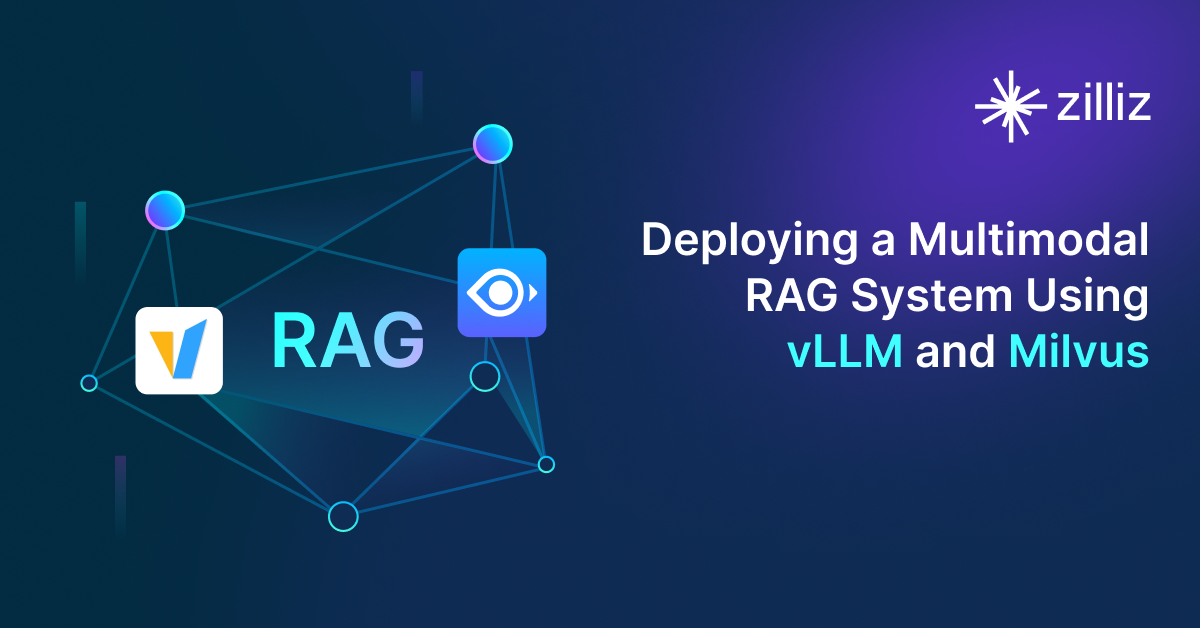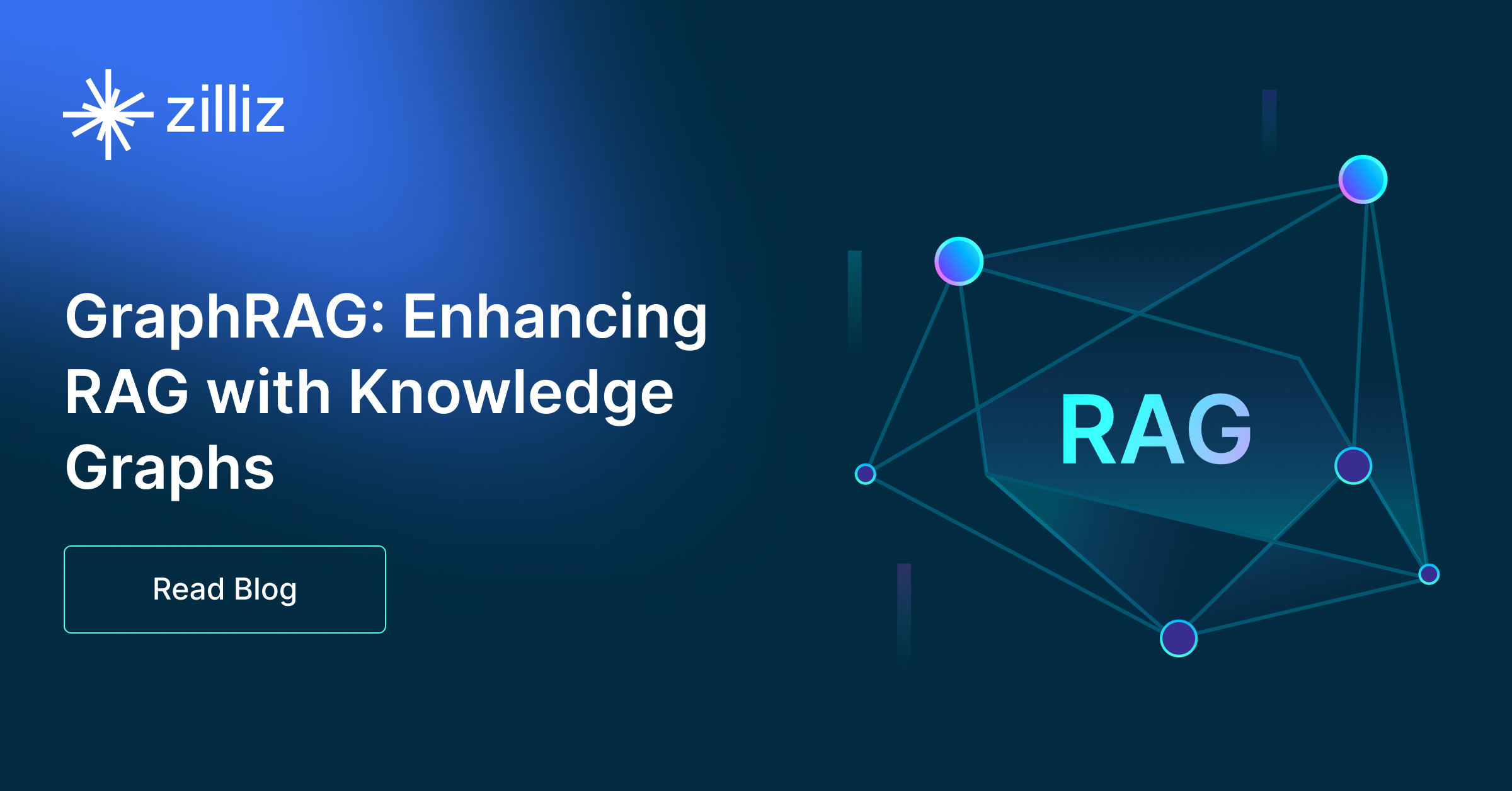Build RAG Chatbot with LangChain, Milvus, Google Vertex AI Gemini 2.0 Flash Thinking, and Google Vertex AI textembedding-gecko@003
Introduction to RAG
Retrieval-Augmented Generation (RAG) is a game-changer for GenAI applications, especially in conversational AI. It combines the power of pre-trained large language models (LLMs) like OpenAI’s GPT with external knowledge sources stored in vector databases such as Milvus and Zilliz Cloud, allowing for more accurate, contextually relevant, and up-to-date response generation. A RAG pipeline usually consists of four basic components: a vector database, an embedding model, an LLM, and a framework.
Key Components We'll Use for This RAG Chatbot
This tutorial shows you how to build a simple RAG chatbot in Python using the following components:
- LangChain: An open-source framework that helps you orchestrate the interaction between LLMs, vector stores, embedding models, etc, making it easier to integrate a RAG pipeline.
- Milvus: An open-source vector database optimized to store, index, and search large-scale vector embeddings efficiently, perfect for use cases like RAG, semantic search, and recommender systems. If you hate to manage your own infrastructure, we recommend using Zilliz Cloud, which is a fully managed vector database service built on Milvus and offers a free tier supporting up to 1 million vectors.
- Google Vertex AI Gemini 2.0 Flash Thinking: This advanced AI model is designed for rapid, high-quality cognitive analysis and decision-making. It leverages enhanced natural language understanding and generation, enabling seamless interactions. Ideal for real-time applications in customer service, content creation, and intelligent automation, it excels in scenarios that demand quick, insightful responses.
- Google Vertex AI textembedding-gecko@003: This model specializes in generating high-quality text embeddings for diverse applications, including semantic search and content recommendation. It leverages advanced techniques for contextual understanding, ensuring accurate representations of intricate text. Ideal for integration into systems needing scalable and efficient NLP solutions, enhancing user experience in real-time applications.
By the end of this tutorial, you’ll have a functional chatbot capable of answering questions based on a custom knowledge base.
Note: Since we may use proprietary models in our tutorials, make sure you have the required API key beforehand.
Step 1: Install and Set Up LangChain
%pip install --quiet --upgrade langchain-text-splitters langchain-community langgraph
Step 2: Install and Set Up Google Vertex AI Gemini 2.0 Flash Thinking
pip install -qU "langchain[google-vertexai]"
# Ensure your VertexAI credentials are configured
from langchain.chat_models import init_chat_model
llm = init_chat_model("gemini-2.0-flash-thinking-exp-01-21", model_provider="google_vertexai")
Step 3: Install and Set Up Google Vertex AI textembedding-gecko@003
pip install -qU langchain-google-vertexai
from langchain_google_vertexai import VertexAIEmbeddings
embeddings = VertexAIEmbeddings(model="textembedding-gecko@003")
Step 4: Install and Set Up Milvus
pip install -qU langchain-milvus
from langchain_milvus import Milvus
vector_store = Milvus(embedding_function=embeddings)
Step 5: Build a RAG Chatbot
Now that you’ve set up all components, let’s start to build a simple chatbot. We’ll use the Milvus introduction doc as a private knowledge base. You can replace it with your own dataset to customize your RAG chatbot.
import bs4
from langchain import hub
from langchain_community.document_loaders import WebBaseLoader
from langchain_core.documents import Document
from langchain_text_splitters import RecursiveCharacterTextSplitter
from langgraph.graph import START, StateGraph
from typing_extensions import List, TypedDict
# Load and chunk contents of the blog
loader = WebBaseLoader(
web_paths=("https://milvus.io/docs/overview.md",),
bs_kwargs=dict(
parse_only=bs4.SoupStrainer(
class_=("doc-style doc-post-content")
)
),
)
docs = loader.load()
text_splitter = RecursiveCharacterTextSplitter(chunk_size=1000, chunk_overlap=200)
all_splits = text_splitter.split_documents(docs)
# Index chunks
_ = vector_store.add_documents(documents=all_splits)
# Define prompt for question-answering
prompt = hub.pull("rlm/rag-prompt")
# Define state for application
class State(TypedDict):
question: str
context: List[Document]
answer: str
# Define application steps
def retrieve(state: State):
retrieved_docs = vector_store.similarity_search(state["question"])
return {"context": retrieved_docs}
def generate(state: State):
docs_content = "\n\n".join(doc.page_content for doc in state["context"])
messages = prompt.invoke({"question": state["question"], "context": docs_content})
response = llm.invoke(messages)
return {"answer": response.content}
# Compile application and test
graph_builder = StateGraph(State).add_sequence([retrieve, generate])
graph_builder.add_edge(START, "retrieve")
graph = graph_builder.compile()
Test the Chatbot
Yeah! You've built your own chatbot. Let's ask the chatbot a question.
response = graph.invoke({"question": "What data types does Milvus support?"})
print(response["answer"])
Example Output
Milvus supports various data types including sparse vectors, binary vectors, JSON, and arrays. Additionally, it handles common numerical and character types, making it versatile for different data modeling needs. This allows users to manage unstructured or multi-modal data efficiently.
Optimization Tips
As you build your RAG system, optimization is key to ensuring peak performance and efficiency. While setting up the components is an essential first step, fine-tuning each one will help you create a solution that works even better and scales seamlessly. In this section, we’ll share some practical tips for optimizing all these components, giving you the edge to build smarter, faster, and more responsive RAG applications.
LangChain optimization tips
To optimize LangChain, focus on minimizing redundant operations in your workflow by structuring your chains and agents efficiently. Use caching to avoid repeated computations, speeding up your system, and experiment with modular design to ensure that components like models or databases can be easily swapped out. This will provide both flexibility and efficiency, allowing you to quickly scale your system without unnecessary delays or complications.
Milvus optimization tips
Milvus serves as a highly efficient vector database, critical for retrieval tasks in a RAG system. To optimize its performance, ensure that indexes are properly built to balance speed and accuracy; consider utilizing HNSW (Hierarchical Navigable Small World) for efficient nearest neighbor search where response time is crucial. Partitioning data based on usage patterns can enhance query performance and reduce load times, enabling better scalability. Regularly monitor and adjust cache settings based on query frequency to avoid latency during data retrieval. Employ batch processing for vector insertions, which can minimize database lock contention and enhance overall throughput. Additionally, fine-tune the model parameters by experimenting with the dimensionality of the vectors; higher dimensions can improve retrieval accuracy but may increase search time, necessitating a balance tailored to your specific use case and hardware infrastructure.
Google Vertex AI Gemini 2.0 Flash Thinking optimization tips
Gemini 2.0 Flash Thinking is designed for rapid yet thoughtful responses in RAG systems. Optimize retrieval by focusing on high-confidence document matching, reducing unnecessary data processing. Keep prompts structured, providing key details upfront while avoiding excessive context. Adjust temperature settings (0.1–0.3) to fine-tune response diversity. Use caching to reduce API overhead for repeated queries. Take advantage of Google Cloud’s GPU-accelerated processing to improve throughput. If using Flash Thinking alongside larger models, assign it to medium-complexity reasoning tasks that require faster turnaround than Pro models but more depth than standard Flash.
Google Vertex AI textembedding-gecko@003 optimization tips
Google Vertex AI textembedding-gecko@003 is designed for advanced text understanding, making it ideal for high-accuracy RAG applications. Optimize embedding generation by removing noisy data and focusing on the most relevant content within documents. Use efficient vector search algorithms, such as FAISS with IVF or HNSW, to ensure fast and accurate document retrieval. Batch text embeddings for large volumes of data to speed up processing and minimize latency. Implement caching for high-frequency queries and periodically refresh embeddings to keep up with changes in the data landscape. Fine-tune the model on domain-specific tasks to improve relevance in specialized RAG applications. Consider deploying a multi-stage search strategy with semantic and keyword-based approaches for optimal accuracy and performance.
By implementing these tips across your components, you'll be able to enhance the performance and functionality of your RAG system, ensuring it’s optimized for both speed and accuracy. Keep testing, iterating, and refining your setup to stay ahead in the ever-evolving world of AI development.
RAG Cost Calculator: A Free Tool to Calculate Your Cost in Seconds
Estimating the cost of a Retrieval-Augmented Generation (RAG) pipeline involves analyzing expenses across vector storage, compute resources, and API usage. Key cost drivers include vector database queries, embedding generation, and LLM inference.
RAG Cost Calculator is a free tool that quickly estimates the cost of building a RAG pipeline, including chunking, embedding, vector storage/search, and LLM generation. It also helps you identify cost-saving opportunities and achieve up to 10x cost reduction on vector databases with the serverless option.
 Calculate your RAG cost
Calculate your RAG cost
What Have You Learned?
What a journey we’ve had together in this tutorial! You’ve just unlocked the powerful combination of a framework, a vector database, an LLM, and an embedding model to create a cutting-edge Retrieval-Augmented Generation (RAG) system. It’s truly inspiring to see how these components can seamlessly integrate to enhance your applications. The framework you’ve explored acts as the backbone, harmonizing each element so they work in perfect synergy. With Milvus as your vector database, you’ve enabled lightning-fast searches, allowing you to retrieve relevant data in the blink of an eye.
Just imagine the conversational possibilities with Google Vertex AI Gemini 2.0 Flash Thinking – it empowers your system with sophisticated conversational intelligence that can engage users like never before. And let’s not forget about the embedding model – generating rich semantic representations that elevate the context of your queries, making your responses more meaningful and relevant.
Throughout this tutorial, you also picked up some nifty optimization tips and a handy cost calculator to keep your RAG systems efficient and budget-friendly. Now it’s time for you to take the reins! Dive in and start building, optimizing, and pushing the boundaries of your own RAG applications. The sky's the limit, and I can't wait to see what you create! Let your imagination run wild, and remember: innovation starts with you. Happy building!
Further Resources
🌟 In addition to this RAG tutorial, unleash your full potential with these incredible resources to level up your RAG skills.
- How to Build a Multimodal RAG | Documentation
- How to Enhance the Performance of Your RAG Pipeline
- Graph RAG with Milvus | Documentation
- How to Evaluate RAG Applications - Zilliz Learn
- Generative AI Resource Hub | Zilliz
We'd Love to Hear What You Think!
We’d love to hear your thoughts! 🌟 Leave your questions or comments below or join our vibrant Milvus Discord community to share your experiences, ask questions, or connect with thousands of AI enthusiasts. Your journey matters to us!
If you like this tutorial, show your support by giving our Milvus GitHub repo a star ⭐—it means the world to us and inspires us to keep creating! 💖
- Introduction to RAG
- Key Components We'll Use for This RAG Chatbot
- Step 1: Install and Set Up LangChain
- Step 2: Install and Set Up Google Vertex AI Gemini 2.0 Flash Thinking
- Step 3: Install and Set Up Google Vertex AI textembedding-gecko@003
- Step 4: Install and Set Up Milvus
- Step 5: Build a RAG Chatbot
- Optimization Tips
- RAG Cost Calculator: A Free Tool to Calculate Your Cost in Seconds
- What Have You Learned?
- Further Resources
- We'd Love to Hear What You Think!
Content
Vector Database at Scale
Zilliz Cloud is a fully-managed vector database built for scale, perfect for your RAG apps.
Try Zilliz Cloud for Free


